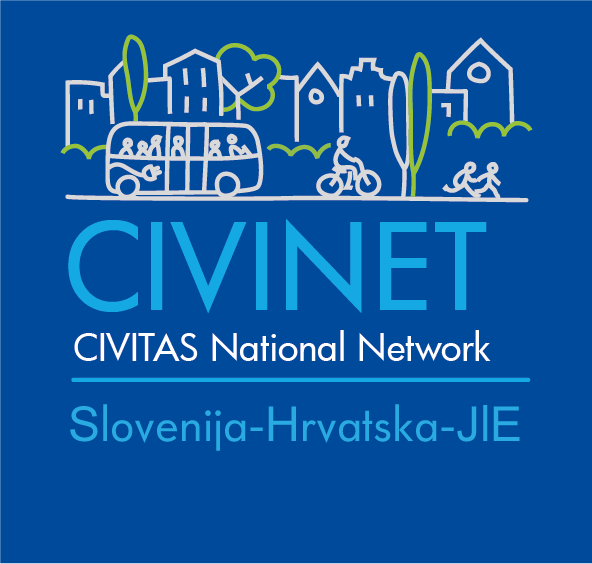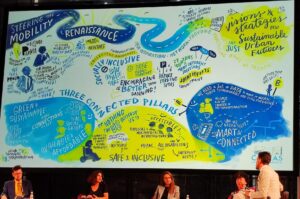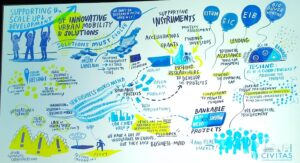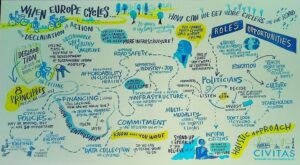8. 10. 2024. | Activities
About the Renaissance of Sustainable Mobility from the CIVITAS Forum 2024 in Parma
The CIVITAS Forum 2024 took place from October 1st to 3rd in Parma. Main topic of the conference was "Join the Mobility Renaissance." Over the three days of workshops, interactive panel discussions, and lectures, knowledge and best practices were exchanged among representatives of national, regional, and local authorities, civil society organizations, academia, mobility experts, and the business sector. Members of the CIVINET Slo-Cro-SEE network from Croatia, Slovenia, and Bosnia and Herzegovina also participated, some actively contributing through presentations and panel discussions.
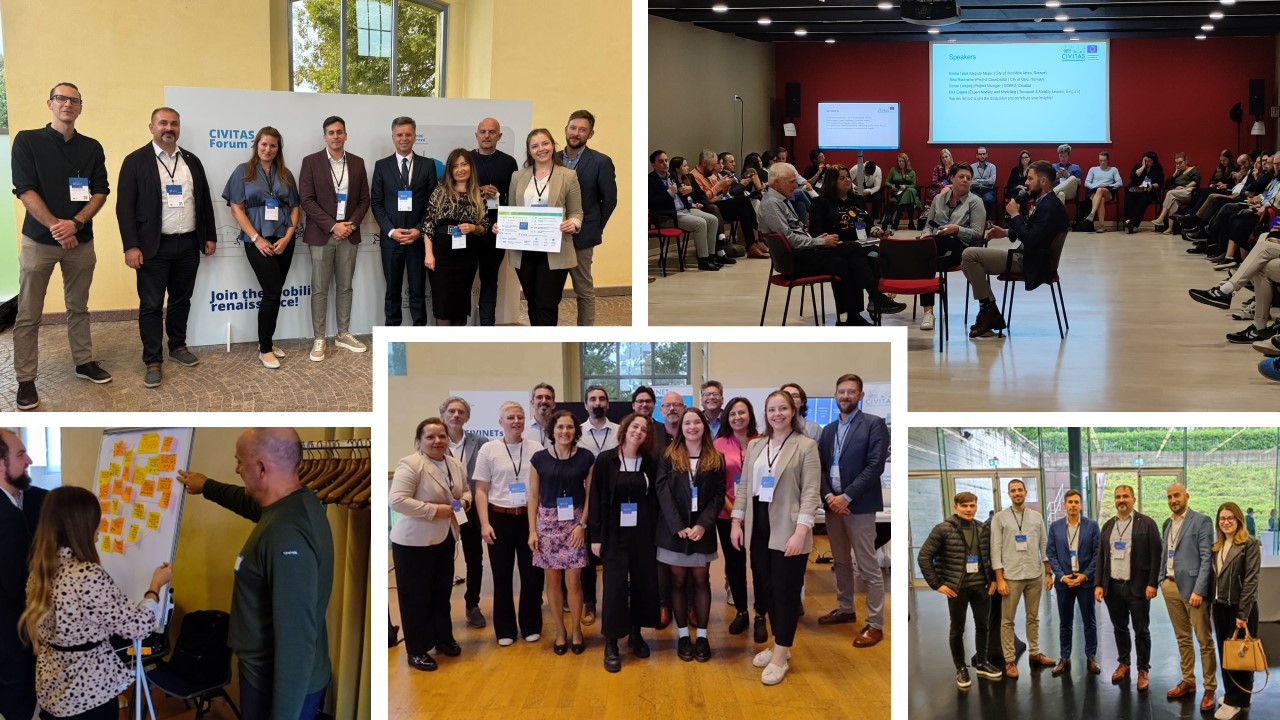
Did you know that the average increase in car length by 20 cm between 2002 and 2022 has taken up an additional 50,000 km of road space for parking across the EU? This was just one of the interesting facts shared in Parma. Moreover, participants had an ideal opportunity to hear from cities and experts about EU policies, project activities, and the latest trends in sustainable mobility in the EU, including innovative solutions with replication potential and experiences from various European cities on implementing measures to support behavioral change towards active and inclusive mobility.
We also met colleagues from partner organizations and projects like SPINE and representatives from other EU project consortia working on innovations and initiatives in sustainable transport and public transit for climate-neutral cities.
During the Forum’s opening session, key stakeholders from the European Commission, Parma, and Italy’s Ministry of Environment and Energy Security presented integrated strategies aligned with broader EU policies and strategies, such as the EU Climate-Neutral Cities Mission, the European Green Deal, the Smart and Sustainable Mobility Strategy, the EU Urban Mobility Framework, and initiatives for the digital transformation of mobility.
The first panel discussion focused on the pillars of sustainable mobility.
- Safe and inclusive mobility is achieved when all user groups are included, with special attention to people with mobility challenges. Addressing diverse needs and collaborating with specific groups ensures accessibility tailored to everyone, in line with the European Pillar of Social Rights.
- Smart, connected, and efficient mobility still requires more data, while technology remains expensive, and the use of artificial intelligence is still unreliable. Improving public transport efficiency was also discussed, alongside EU efforts for a single digital market and intelligent transport systems.
- Climate-neutral and resilient mobility is the EU’s top priority for the upcoming period, but the transition costs are high. Nevertheless, there is a strong commitment from all stakeholders to this goal, with many European cities already sharing their experiences and being encouraged to transfer best practices through various initiatives.
The next panel brought together stakeholders in urban mobility innovations to discuss opportunities and mechanisms for supporting the adoption and scaling of effective and sustainable solutions. These solutions help cities across Europe achieve their climate goals and improve the quality of life for their citizens. A representative from Helsinki’s Innovation Agency explained the city’s vision for researching and implementing innovative solutions, with nine projects currently underway to enhance sustainable mobility. Funding mechanisms for urban mobility from EIT, the European Investment Bank (EIB), and the European Innovation Council (EIC) were also highlighted, supporting innovators in scaling their solutions and cities in implementing them. Finally, a representative from the Big Buyer Initiative shared how public procurement can be a key tool in implementing innovative urban mobility solutions in European cities.
The final plenary panel discussed the European Declaration on Cycling, adopted in April this year. Plans, policies, and strategies at all levels of government recognize the benefits of cycling – sustainability, inclusiveness, health, efficiency, and cost-effectiveness. The panelists emphasized the need for supporting infrastructure to ensure widespread adoption of cycling as one of the primary modes of transportation. They discussed the roles of national organizations, local authorities, researchers, innovators, and other stakeholders in transforming cities into safe and accessible places for cycling. The panelists also reminded everyone that cycling is a fun activity.
Other key topics in the program included how to adapt our cities to modern needs while considering the needs of residents – providing more space for pedestrians, cyclists, and high-quality public transport that is environmentally sustainable, accessible, connected, inclusive, safe, and pleasant. Discussions also addressed how technology, data, and new approaches can bring real changes for better quality of life in cities and how to effectively communicate sustainable mobility.
In an interactive session focused on future urban mobility, with insights and strategies from the CIVITAS Initiative, the emphasis was on using the extensive knowledge base accumulated over the last 30 years, strategies for securing political support for urban mobility projects, and aligning initiatives with sustainable mobility strategies. One of the panelists in this session was Goran Lampelj from ODRAZ. In a session on the electrification of urban mobility, Mateo Uravić from Ernst & Young presented the implementation of public transport in Križevci.
Numerous events, meetings, and workshops were organized leading up to the Forum.
Network members participated in a workshop on improving the guidelines for developing and implementing SUMPs (Sustainable Urban Mobility Plans). The workshop gathered mobility experts from several European countries who worked in groups to identify challenges encountered in the current application of the guidelines, along with their advantages, shortcomings, and lessons learned. Solutions for a new generation of guidelines were proposed and then prioritized by participants.
Some of the suggestions included:
- Better collaboration between national representatives and lower administrative units
- Development of a national-level methodology to ensure all SUMPs are of equal quality
- New forms of financing through public-private partnerships
- Cooperation between neighboring administrative units when developing a SUMP, especially for small and medium-sized cities
- Integration with higher-level plans
- Establishment of national support programs and centers for SUMP quality checks and monitoring, among others.
Additionally, ODRAZ, as the Network Secretariat, participated in the CIVINET network secretariat meeting, where discussions focused on strengthening collaboration. Representatives of the Secretariats also welcomed the new CIVINET Ukraine network.
Members of the CIVINET Slo-Cro-SEE network present at the conference included ODRAZ (the Secretariat), representatives from Ljubljana and Novo Mesto, GIZ Sarajevo, the Urban Planning Institute of the Republic of Slovenia, the Faculty of Transport and Traffic Sciences at the University of Zagreb, Ernst & Young, and the Polytechnic of Šibenik.
Find out more about this conference HERE.
Povratak
